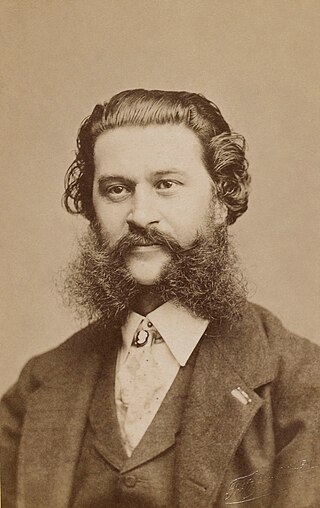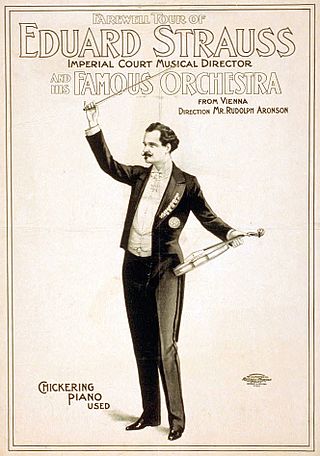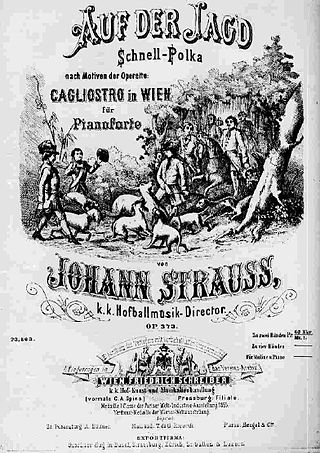Related Research Articles

Johann Baptist Strauss II, also known as Johann Strauss Jr., the Younger or the Son, was an Austrian composer of light music, particularly dance music and operettas as well as a violinist. He composed over 500 waltzes, polkas, quadrilles, and other types of dance music, as well as several operettas and a ballet. In his lifetime, he was known as "The Waltz King", and was largely responsible for the popularity of the waltz in Vienna during the 19th century. Some of Johann Strauss's most famous works include "The Blue Danube", "Kaiser-Walzer", "Tales from the Vienna Woods", "Frühlingsstimmen", and the "Tritsch-Tratsch-Polka". Among his operettas, Die Fledermaus and Der Zigeunerbaron are the best known.

The Vienna New Year's Concert is an annual concert of classical music performed by the Vienna Philharmonic on the morning of New Year's Day in Vienna, Austria. The concert occurs at the Musikverein at 11:15. The orchestra performs the same concert programme on 30 December, 31 December, and 1 January but only the last concert is regularly broadcast on radio and television.
The polka-mazurka is a dance, musically similar to the mazurka, but danced much like the polka. Many polka-mazurkas were composed by Johann Strauss II and his family. Johann Strauss I did not compose any of this type of music; the first polka-mazurka example written by the Strauss family was in the year 1854 by Johann Strauss II, entitled La Viennoise op. 144.The polka-mazurka was not credited to the Strauss family alone, as many Viennese composers in the 1850s era also wrote many examples. This variant of the polka was seen as cross-cultural, as many of its influences can be seen in the French-polka with its feminine and deliberate steps as well as the exciting schnell-polka, where Eduard Strauss composed many famous pieces of this type.
"Die Bajadere" is one of Johann Strauss II's polkas, Op. 351. A bajadere was a temple dancer in the European vision of legendary India being popularized by the first translations of Indian classic literature into European languages. The European view melded all the world east of Suez into an exotic locale. The themes of "Die Bajadere" were drawn from the score of Strauss's first operetta, Indigo und die vierzig Räuber, loosely based on the Arabian Nights, which premiered in 1871 at the Theater an der Wien in Vienna.

Eduard "Edi" Strauss was an Austrian composer who, together with his brothers Johann Strauss II and Josef Strauss made up the Strauss musical dynasty. He was the son of Johann Strauss I and Maria Anna Streim. The family dominated the Viennese light music world for decades, creating many waltzes and polkas for many Austrian nobility as well as dance-music enthusiasts around Europe. He was affectionately known in his family as 'Edi'.

Johann Maria Eduard Strauss III was an Austrian composer whose father was Eduard Strauss, whose uncles were Johann Strauss II and Josef Strauss, and whose grandfather was Johann Strauss I. Born in Vienna, he was unofficially entrusted with the task of upholding his family's tradition after the dissolution of the Strauss Orchestra by his father in 1901. His talents were not fully realized during his lifetime as musical tastes had changed in the Silver Age with more popular composers such as Franz Lehár and Oscar Straus dominating the Viennese musical scene with their operettas, although his uncle, Johann Strauss II, supervised his development as a musician, a fact disputed by Eduard Strauss.

Carl Michael Ziehrer was an Austrian composer. In his lifetime, he was one of the fiercest rivals of the Strauss family; most notably Johann Strauss II and Eduard Strauss.
Cagliostro-Walzer op.370 is a waltz by Johann Strauss II composed in 1875 based on themes from his operetta, Cagliostro in Wien which premiered on 27 February 1875 at the famous Theater an der Wien.

The Gypsy Baron is an operetta in three acts by Johann Strauss II which premiered at the Theater an der Wien on 24 October 1885. Its German libretto by Ignaz Schnitzer is based on the unpublished 1883 story Saffi by Mór Jókai. Jokai later published a novel A cigánybáró in 1885 using an expanded version of this same story.
Ein Herz, ein Sinn! , opus 323 is a polka-mazurka composed by Johann Strauss II in 1868 belonging to a period of creativity of the composer. Strauss dedicated this piece to 'the Committee of the Citizen's Ball' which was held at the Imperial Redoutensaal on 11 February 1868 where on occasion he had earlier also dedicated his waltz Bürgersinn.

Franz Friedrich Richard Genée was a Prussian born Austrian librettist, playwright, and composer.

Cagliostro in Wien is an operetta in three acts by Johann Strauss II to a libretto by F. Zell and Richard Genée. It premiered on 27 February 1875 at the Theater an der Wien, featuring Marie Geistinger and Alexander Girardi.
The Neue Pizzicato-Polka, or New Pizzicato Polka, Op. 449, was composed by Johann Strauss II in early 1892 for concerts to be given under Eduard Strauss in Hamburg. Strauss later placed the work as a ballet between the second and third acts of his operetta Fürstin Ninetta. It is scored as its name implies for plucked strings.
Bitte schön!, opus 372, is a polka composed by Johann Strauss II. The first two themes of the composition incorporate Strauss' operetta Cagliostro in Wien. The composition was first performed in the summer of 1872.

"Auf der Jagd", op. 373, is a polka composed by Johann Strauss II. The composition is based on melodies in Strauss' operetta Cagliostro in Wien.

Der Karneval in Rom —also known as Karneval in Rom— is an operetta in three acts composed by Johann Strauss II to a libretto by Josef Braun, Richard Genée and Maximilian Steiner. It was Strauss' second operetta and based on Victorien Sardou's 1861 comedy Piccolino. The work premiered on 1 March 1873 at the Theater an der Wien.
Carnevalsbilder, opus 357, is a waltz composed by Johann Strauss II. The waltz is based on melodies from Strauss' operetta Der Karneval in Rom. Strauss conducted its first performance in Vienna on July 9, 1873. Oscar Straus later arranged the second waltz theme of Carnevalsbilder for his operetta Drei Walzer as the soprano aria Ich liebe das Leben.
Waldine, Op. 385, is a polka-mazurka composed by Johann Strauss II. The title is taken from one of Strauss' operettas, Blindekuh. Waldine was the last, as well as the least successful, of the five orchestral dance compositions that Strauss had arranged on tunes from the operetta, having been first performed an entire year after the premiere of the operetta, where it was conducted by Eduard Strauss in the Musikverein in Vienna on December 7, 1879.

Das Spitzentuch der Königin is an operetta by Johann Strauss II. The libretto by Heinrich Bohrmann-Riegen and Richard Genée was based on the Spanish writer Cervantes.
References
Based on original text by Peter Kemp, The Johann Strauss Society of Great Britain. Used with permission.